Easy Palette Knife Oil Painting of Waves Crashing Against Rocks
When it comes to painting with thicker paint, you don't have to stick with using a brush. You can also use a palette knife to apply the paint to the canvas.
Palette knife painting is a fun, immediate, and expressive way of adding colour to your artwork. By choosing a palette knife as a tool to apply paint, you can achieve thick texture in your works.
In this guide, you will find all the essential information you need to start palette knife painting. Learn about the benefits, essential tips and techniques, plus get inspired by some talented painters who use palette knives as their applicator of choice.
Disclaimer: Fine Art Tutorials is a reader supported site. When you make purchases through links on this site, we may earn a small commission at no extra cost to you.
What is palette knife painting?
Palette knife painting is a type of painting that is done using a palette knife instead of a brush. This type of painting can create thick, interesting textures and patterns that are not possible with a brush.
The advantages of painting with palette knife

With a palette knife, artists can cover their surface much more quickly than with a brush. Scoop up some paint with the knife and spread it across the surface to cover the white of the canvas. Get a large, flat palette knife to speed up your painting process.
Another advantage to painting with a palette knife is that artists can achieve thick texture on the canvas. By using viscous mediums that hold their shape, painters can create three dimensional looking peaks.
Palette knives are cheap, often cheaper than quality stiff oil painting brushes, plus they're easy to clean and last longer. To clean a palette knife, all you have to do is wipe paint from the knife with a paper towel. Brushes can degrade over time, especially if you wash them in solvents. However palette knives will stand the test of time.
Palette knives are a multi purpose tool. It's likely that if you work with acrylics or oil paints that you own a few palette knives already. You can also use them for mixing colours on the palette.
How do you paint with a palette knife?
Painting with a palette knife is easy and intuitive. Some artists prefer to load the paint onto the knife and then apply it to the canvas. Others may use the knife to scrape away layers of paint to create interesting effects. Experiment and find what works best for you!
What are some tips for palette knife painting?

Here are a few tips to help you get started with palette knife painting:
- Start with a small canvas. This will help you get used to the techniques and avoid wasting paint.
- Use thicker paints. This will make it easier to load the paint onto the knife and create interesting textures.
- Use a variety of knives. Different knives will create different effects. Experiment to find the ones you like best.
- Mix up your palette knife strokes. Vary long and short strokes, thick and thin paint and types of texture to create a sense of depth in the painting.
- Interchange using a palette knife and brush. You don't have to use just one tool throughout the painting process. Grab a brush to blend edges, or create fine details. Another great way to use brushes alongside palette knives is to complete a painting with brushes, then paint one or several impasto strokes to create emphasis in the painting. Use the salience of texture against an untextured painting to draw the viewer's eye into a focal point .
- It's difficult achieving accurate lines and fine details with palette knives, so let go and apply the paint expressively!
- Clean up straight after painting . If you let paint harden on a palette knife, it can be tricky to remove.
- Practice, practice, practice! The more you paint with a palette knife, the better you will become at it.
Painting mediums suitable to use with palette knives
Painting mediums that work fantastically with palette knives are oil paints and heavy body acrylic paints , like Golden Heavy Body . It's the thick paints that work best with stiff tools like palette knives. Runny paints like watercolour, gouache or soft body acrylics aren't suitable for applying with palette knives, as you need a soft, flexible absorbent applicator like a brush to hold the paint and spread it across the surface.
Artists add additional mediums to their paint to thicken texture even further. Mix oil paint with cold wax to add body and thicken the paint to help it retain texture on the canvas. On top of these attributes, cold wax will make paint appear more matte and dry faster.
The Winsor & Newton Impasto medium thickens oil paint and makes it dry quicker. This medium dries to a glossy finish and is made from alkyd resin.
There are mediums that can be mixed in with acrylic paint too, for the purpose of palette knife painting. For example gel mediums with add thickness and body to the paint and modelling paste will add even more thickness.
Palette knife painting techniques
Now that you know the advantages of painting with a palette knife and what type of mediums to use, let's look at some specific techniques you can try out.
Impasto

The first technique we're going to look at is impasto . Impasto is a painting technique that involves using thick paint to create texture on the canvas. This type of painting is often done with a palette knife, however artists sometimes use stiff brushes too.
To create an impasto painting, start by loading your palette knife with paint. Then, apply the paint to the canvas in a thick layer. You can use different strokes to create different effects. For example, you can use a stabbing motion to create short peaks of paint, or a dragging motion to create furrows. Mix up your painting strokes to create variety and interest.
You can also build up layers of paint to create even more texture. Just make sure that each layer is dry before you add the next one on top.
Sgraffito
Sgraffito is another interesting technique that can be done with a palette knife (or any other sharp object). To create a sgraffito painting, start by applying a layer of paint to your canvas. Once the first layer is dry, apply a second layer on top.
While the second layer is still wet, use your palette knife to scratch through the wet paint and reveal the layer underneath. You can create different patterns and designs by varying the pressure you apply and the direction of your strokes. Use the edge, or tip of the palette knife to etch details into the paint.
Once you're happy with your painting, leave it to dry completely. Then, you can varnish it to protect the surface.
Mix paint on the canvas
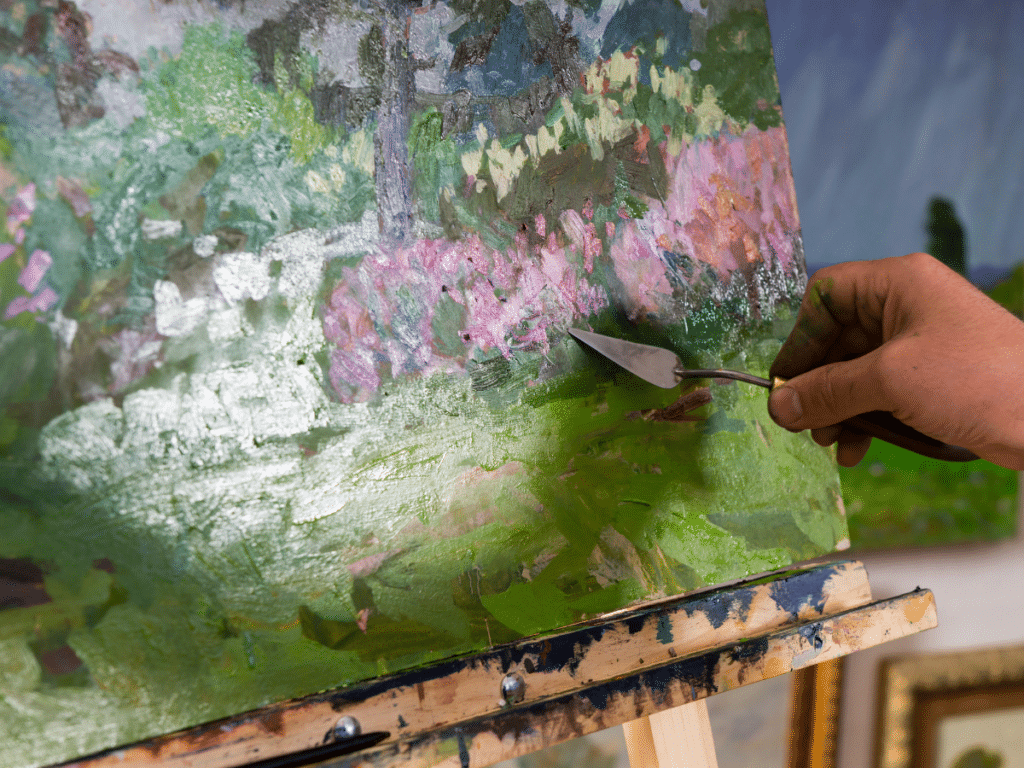
Instead of mixing paint on the palette, load your knife with two or more colours. Then, paste it onto the surface, watching the colours swirl together. Many impressionist painters did this, as pigments sitting next to one another unmixed appear brighter and can add more variety to a painting. When the artist steps back to view the painting as a whole, the colours can appear to mix optically.
Blending with a palette knife

To soften edges between colours on the surface, make sure your palette knife is clean and drag the edges of the colours together until they overlap. To create a smooth gradient with a palette knife, mix transitional shades of colours before blending.
Scrape thin layers with a palette knife
Add a small amount of paint to the edge of the knife, hold the knife at a 45 degree angle and scrape the paint across the surface. This techniques only works on flat surfaces, as opposed to surfaces with lots of texture on already. It would work great to add a thin layer of paint over an underpainting for example. If the paint is thin enough and you're painting with a transparent, or semi transparent pigment, the colours from the previous layer of the painting would show through. Therefore, this technique can work to alter previous layers of colour.
Create a textured ground
With acrylic paints and modelling paste , you can paint with a palette knife to create wonderful texture on the surface, leave it to dry, then paint over with regular thin acrylics and a brush. This is a great way to establish texture in the first layer of the painting, then you have the option to paint with thinner details and glazes over the top. The modelling paste layer has tooth to it, so it acts as a ground over the gesso canvas.
Alla prima
Alla prima is a technique usually used with oil paints, whereby the painter completes a painting in one sitting. Wet paint is layered on top of wet paint, instead of waiting for layers to dry to create separate colours. This technique can be used with palette knives. Start the painting with thinner layers and slowly build up the thickness of the paint. Mix your colours on the palette and paint intentionally. Try to apply the colour directly to the surface in the place you want it to appear, instead of using multiple layers to alter colours.
Get creative with the palette knife tool. There are a variety of gestures and techniques you can use to be expressive with the applicator. Use it to scrape away paint from the surface to create interesting marks and patterns, or use the edge of the knife to make fine, precise lines. Make up your own gestures and techniques, afterall, the fun of art is in experimenting!
The best palette knives for artists
There are lots of different kinds of palette knives you can get, the shape, size and material of the knife will affect the final outcome of the painting.
Look for palette knives with a flexible yet sturdy, stainless steel blade and a handle that makes gripping easy.
Liquitex painting knives
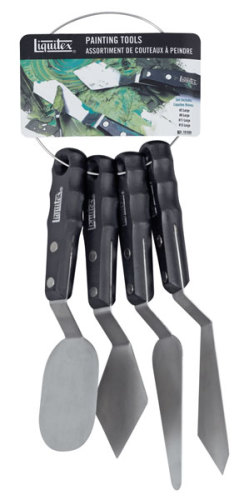
With a 36 knives made available to artists, Liquitex make their sturdy steel blades in a range of shapes and sizes.
Choose from large diamond shaped knives that will cover large areas of the canvas, or small knives for detail work. With the no. 12 knife you can paint impasto strokes with ease and precision.
RGM palette knives
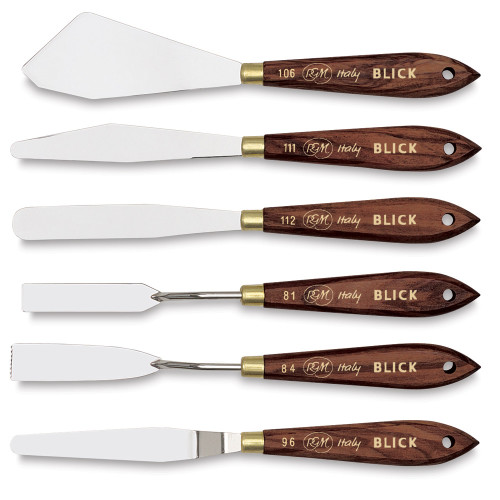
RGM are another brand that makes quality palette knives for mixing and painting with. Their set of spatula knives are easy to hold and perfect for the impasto technique. Their range of New Age knives come in unique shapes, perfect for creating interesting texture on the canvas. RGM blades are made from flexible stainless steel, making them the perfect tool for texture work and spreading paint across the canvas.
Subjects to paint with a palette knife
Artists can paint any subject they please with a palette knife, however there are certain subjects that especially suit being painted with the tool.
Cityscapes and architecture palette knife paintings
Cityscapes and architecture make excellent subjects for palette knife painting. Use the edge of the knife to draw straight angular lines. Etch into wet paint to create the impression of brick work.
Landscape palette knife painting

Landscapes are another subjects that suit being painted with textured effects. Swirl white paint onto blue for broken cloud effects, use the sgraffito technique to scrape away one tone of green from another to create variety of grass tones. Rocks are another subject that work well with the palette knife, create jagged edges and dark crevices with one sweep of the knife. The impression of organic and natural subjects can be painted without much thought or effort with a knife.
Paint a seascape with palette knives
Seascapes also lend themselves well to being palette knife paintings. Swirls of white and blue can create dramatic stormy skies, while the knife can be used to scrape away at the wet paint to make crashing waves.
Portrait painting with palette knives
Portrait paintings usually have a soft appearance, however you can create a sense of contrast by painting with a palette knife.
Palette knife painting flowers
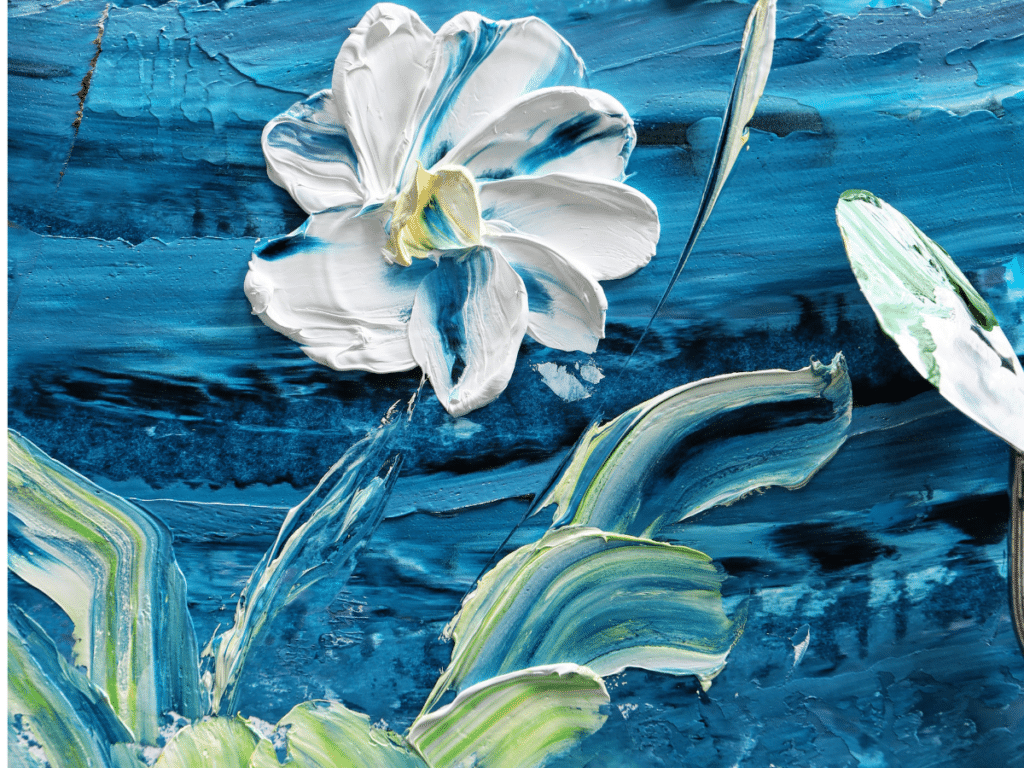
One of the most popular subjects to paint with a palette knife are flowers. The round, soft petals can be easily blended with the applicator to create a beautiful effect.
Palette knife painting examples
Looking for some palette knife painting inspiration? Check out the work of these talented artists.
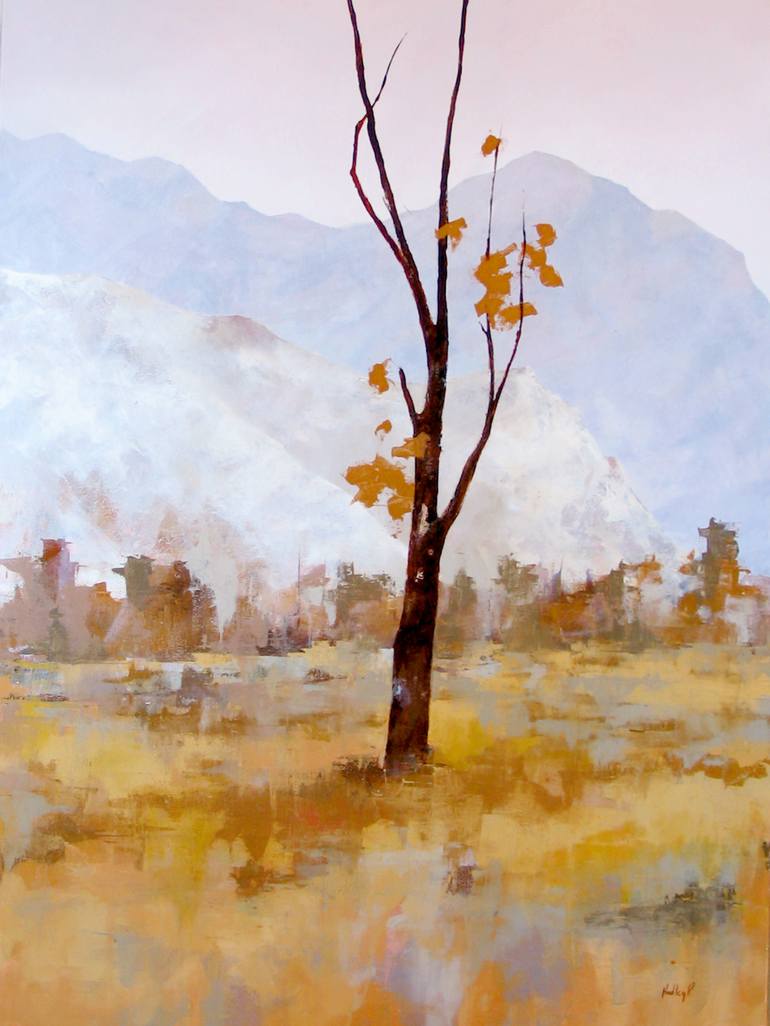
'Linger' by Hadley Rampton is a palette knife painting on canvas, made with oils. Hadley Rampton represents the beauty of nature with atmosphere and light.

'Pink House Restaurant' is an original palette knife oil painting by Assel Kystaubayeva of a restaurant in Paris. This colourful oil painting looks detailed, but get up close and you can see the textured palette knife marks.
Step-by-step palette knife painting video tutorials
Want to see some palette knife painting in action? These video tutorials will walk you through the process step-by-step, so you can try it for yourself.
This video runs through some unique textures and gestures you can make with palette knives. Palette knives are a versatile tool that can make a range of marks. Learn to make lines and blend colour with your knife.
Paint a spectacular mountain range, with large snowy mountains, distant trees and winter light. Use a large spatula palette knife to work quickly on a large canvas. You don't have to spend much time working on details to create an effective piece, but by adding a few details here and there, you can create a sense of depth and immersion in the scene.
What styles of art suit palette knife painting?
Expressionist, impressionist and abstract painting styles are all suited to being created with a palette knife. The gestural nature of the applicator lends itself well to these styles of painting.
Famous artists who have used palette knives in their painting include Vincent van, Jackson Pollock and Willem de Kooning.
Finally
Now that you know all about palette knife painting, why not give it a try yourself? Get creative and experiment with the different techniques you can use. Most importantly, have fun!
If you've found anything on this site especially useful, you can make a donation to me through PayPal. I take a lot of time to research and write each topic, making sure each tutorial is as detailed as possible and I make all my content freely available. Any small donation (even the price of a cup of coffee!) can help me to cover the running costs of the site. Any help from my readers is much appreciated :).
Follow the link in the button below to support this site.
scarbroughupout1948.blogspot.com
Source: https://finearttutorials.com/guide/palette-knife-painting/
0 Response to "Easy Palette Knife Oil Painting of Waves Crashing Against Rocks"
Post a Comment